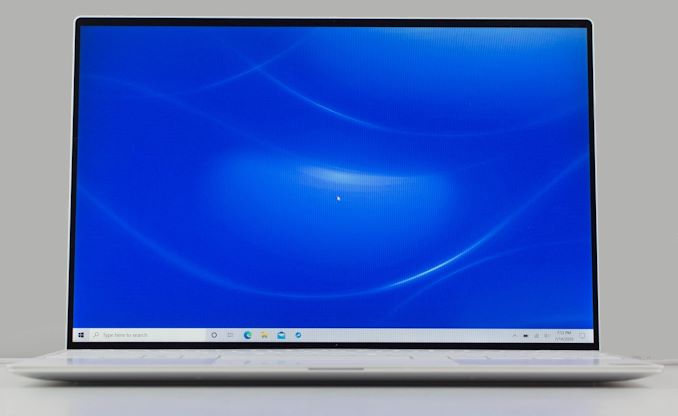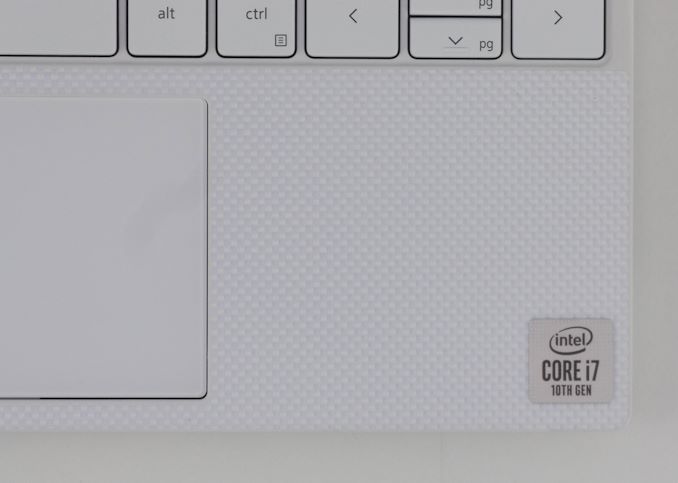The Dell XPS 13 (9300) Review: Return of the King
by Brett Howse on July 16, 2020 10:00 AM EST
Dell changed the Windows laptop market in a single stroke with the launch of the updated XPS 13 back in 2015, ushering in the world of the InfinityEdge display, and moving the entire industry forward. We were fortunate enough to get a chance to check out the precursor to the new XPS 13 back in November, with a review of the XPS 13 2-in-1. Dell had chosen not to rest on their laurels, and the 2-in-1 proved to be one of the best notebooks around if you needed a compact and powerful convertible laptop. Today we are evaluating the traditional clamshell version of the XPS 13, and while it offers many of the same features and design touches, it does so in a more familiar form factor that many customers are going to prefer.
For the 2020 refresh, Dell has made the refreshing move to taller displays, as we saw with the XPS 13 2-in-1. As a result the XPS 13 uses 13.4-inch display panel with a 16:10 aspect ratio, offering more vertical space for getting work done, and some convenient padding to place controls when watching 16:9 content. The larger display fits into a chassis that is actually 2% smaller than the outgoing design, with the new XPS 13 offering a 91.5% screen to body ratio.
This is actually the second time that Dell has refreshed the XPS 13 within the last year. The company previously updated the XPS 13 in August 2019 to use Intel's 10th generation Core processors, but presumably due to limited supply of Intel’s then-new Ice Lake platform, Dell opted to launch that iteration with Comet Lake-U processors. And under more normal circumstances we would have expected Dell to stick with an annual cadence – and thus Comet Lake – for an entire year. Instead, to some surprise, Dell gave the XPS 13 a further mid-generation refresh, launching the Ice Lake-based XPS 13 9300 model that we are reviewing today, and bringing the clamshell XPS 13 to parity with the 2-in-1 version.
The switch from Comet Lake to Ice Lake, in turn, is a significant one. it means the XPS 13 gets Intel’s new Sunny Cove CPU architecture, as well as the much-improved Gen 11 graphics. Dell offers Core i3, i5, and i7 models, with the Core i3 and i5 offering G1 graphics, meaning 32 Execution Units (EUs), and the top-tier Core i7-1065G7 featuring the full 64 EUs on the GPU side. Just as a comparison, the Comet Lake-U only offered 24 EUs of Gen 9.5 graphics, so even the base Ice Lake models still offer a 33% larger (and much newer) GPU than the outgoing models.
The move to Ice Lake also brings some badly-needed LPDDR4X support, which in turn means a 32 GB maximum memory option in the XPS 13 9300, up from 16 GB previously. Although Dell still lists a paltry 4 GB option on their specifications sheet, a quick look at the Dell.com site shows that, at least in the USA, it appears that 8 GB is the new minimum, and that is a welcome change. Offering just 4 GB of RAM in a premium Ultrabook was always a poor choice, even if it did allow Dell to hit a slightly lower price bracket. On the storage front there is more good news, with 256 GB the new minimum, with up to 2 TB available, and all drives are PCIe x4 NVMe offerings.
| Specifications of the Dell XPS 13 9300-Series | |||
| General Specifications As Tested: Core i7-1065G7 / 16GB / 512GB / 1920x1200 |
|||
| LCD | Diagonal | 13.4-inch | |
| Resolution | 1920×1200 | 3840×2400 | |
| Brightness | 500 cd/m² | 500 cd/m² | |
| Contrast Ratio | 1800:1 | 1500:1 | |
| Color Gamut | 100% sRGB | 100% sRGB 90% P3 |
|
| Features | Dolby Vision | Dolby Vision | |
| Touch Support | with or without touch | Yes | |
| Protective Glass | Corning Gorilla Glass 6 in case of touch-enabled model | ||
| CPU | Intel Core i3 1005G1 (4MB cache, up to 3.4GHz) Intel Quad Core i5 1035G1 (6MB cache, up to 3.6GHz) Intel Quad Core i7 1065G7 (8MB cache, up to 3.9GHz) |
||
| Graphics | Intel UHD Graphics Intel Iris Plus Graphics |
||
| RAM | 4 - 32 GB LPDDR4X-3733 DRAM (soldered/onboard) | ||
| Storage | 256 GB PCIe 3.0 x4 SSD 512 GB PCIe 3.0 x4 SSD 1 TB PCIe 3.0 x4 SSD 2 TB PCIe 3.0 x4 SSD |
||
| Wireless | Killer AX1650 Wi-Fi 6 + Bluetooth 5.0 (based on Intel's silicon) Killer AX500 Wi-Fi 6 + Bluetooth 5.0 (based on Qualcomm's silicon) |
||
| USB | 3.1 | 2 × TB 3/USB Gen 3.1 Gen 2 Type-C | |
| 3.0 | - | ||
| Thunderbolt | 2 × TB 3 (for data, charging, DP displays) | ||
| Cameras | Front | 720p HD webcam | |
| Other I/O | Microphone, 2 stereo speakers, audio jack | ||
| Battery | 52 Wh | 45 W AC Adapter (USB Type-C) | ||
| Dimensions | Width | 295.7 mm | 11.64 inches | |
| Depth | 198.7 mm | 7.82 inches | ||
| Thickness | 14.8 mm | 0.58 inches | ||
| Weight | non-touch 1.2 kilograms | 2.64 pounds touch-enabled 1.27 kilograms | 2.8 pounds |
||
| Launch Price | Starting at $999.99 | ||
Dell has gone all-in on USB-C with the new XPS 13, with one port on each side of the notebook. Both feature Thunderbolt 3 with 4 lanes, as well as power delivery for charging. The lack of a Type-A port may inconvenience some, but Dell does include an adapter in the box to assist. Wireless is the Killer AX1650, which based on the latest Intel AX200 wireless adapter – and with Intel purchasing Killer this partnership seems like it is not going anywhere.
If you read our review of the 2-in-1 version of this laptop, you will undoubtedly notice a lot of similarities. As they are from the same product line, that is not an accident: Dell has now refreshed their entire XPS series of laptops with a similar design philosophy. Let’s take a peek at what is new.











224 Comments
View All Comments
Erulian - Thursday, July 16, 2020 - link
My received 2 in 1 has many parts that did not fit well. For example, the screen's topmost layer bulges out at the bottom of the frame, and a few keys are poorly stabilized. The hinge is also too stiff, making opening the laptop a two-handed job. I wonder if I got an early production version as a result of the rush to get units out to customers. The OS install also feels stuttery at times. Since these issues do not impact normal use, I've so far not bothered with informing Dell.iq100 - Thursday, July 16, 2020 - link
When the XPS 15 9560 was purchased with on site service, it took six attempts to get it to work.Here are the parts replaced on just the last (sixth) attempt.
SERVICE REPORT
REPLACEMENT PARTS
No. Dell Part QTY Description Parts Retained by Customer
1 5R1JP 1 ASSY,CVR,BTM,W/BDG,9550 No
2 M0T6P 1 ASSY,PLMRST,W/FPR,80,9560 No
3 9TXK7 1 ADPT,AC,130W,DLTA,4.5,L6,V2,E5 No
4 RN699 1 ADPT,CON,VID,DNGL,DP2VGA,L No
5 64TM0 1 ASSY,CBL,DC-IN, 9550/5510 No
6 2JVNJ 1 CORD,PWR,125V,2.5A,1M,C5,E5,US No
7 5G0HC 1 ASSY,PWA,DTRBD,AUDIO,9560/5520 No
Old wounds, not healed only fester. I purchase two U3011s. Both suffered the same design defect. Dell replace one but NOT the other, claiming "it was their policy to replace only one". Go figure.
www.tinyurl.com/HellIsDell
grant3 - Friday, July 17, 2020 - link
You're making me feel better... The xps-15-7500 6 weeks ago hasn't seen a day of use yet because of the massive delays in getting the touchpad + fingerprint defects fixed.I'm surprised the hardware is never tested on new machines before being shipped.
ET - Thursday, July 16, 2020 - link
My XPS 13 9350 definitely could use an upgrade, but I'd rather have a Ryzen in my laptop.eastcoast_pete - Thursday, July 16, 2020 - link
Looks nice, just one major downside, and one "wish they'd made that available": the major downside is the complete absence of a USB type A connector. I know they include an adapter, but that's just one more thing to forget or lose. If a Surface tablet has enough space for one, the XPS should have space for one, too. 2 USB-C/TB + one USB A 3.2, and it'd be almost perfect. The other "complaint" is the battery size. I'd gladly pay a bit extra and lug another 200 g around and have a 90 Wh battery - now that'll be a "whole day without recharge" ultraportable.And yes, it would have been nice to have a 4800u as a processor option, but these units are designed over a year before rollout, and AMD wasn't all that ready to rumble last summer. Now they are, and I hope that Dell will add a Renoir option for their 2021 XPS models.
eastcoast_pete - Thursday, July 16, 2020 - link
Forgot to add: why only one (one!) heatpipe with a 42 W top TDP CPU? C'mon, Dell, add the 50 or 100g weight for a second heatpipe and give the thing the cooling it deserves!Deicidium369 - Thursday, July 16, 2020 - link
and will be going against the massively superior Tiger Lake - MX350 level graphics, and 17% slower with half the cores (4 vs 8) than the top end Renoir. Unlikely to ever see an AMD in an XPS13 class machine.tamsysmm - Friday, July 17, 2020 - link
Yeah right, Renoir is such a failure. Only these cheap and low quality models available (ThinkPad X13 13” (AMD) Laptop, LENOVO ThinkPad T14s AMD Ryzen 7 Pro 4750U, HP Elitebook 835/845/855 G7). Oh wait...Korguz - Friday, July 17, 2020 - link
to Deicidium369, ANYTHING AMD makes is a failure.Spunjji - Friday, July 17, 2020 - link
I just don't buy this "AMD weren't ready" shtick. Asus designed an *entirely new class of gaming laptop* around Renoir. It really wouldn't have been difficult for Dell to integrate Renoir into this design - which has released much later in the year than the Zephyrus 14 - if they had had any interest in doing so.Whether this is down to AMD's failure in OEM outreach, Dell's failure in imagination, or standard Intel shenanigans is unclear - but the end result is inferior products and TBH I'm sick of it.